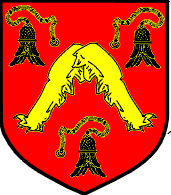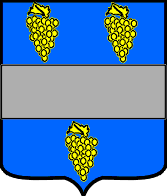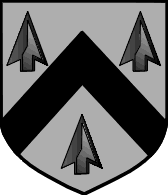


CLASSES OF ARMS IN HERALDRY



According to the received authorities, there are ten classes of Arms;-
1. ARMS OF DOMINION, those borne by Sovereigns and annexed to the territories they govern.
2. ARMS OF PRETENSION, used by Sovereigns who are not in possession of the dominions to
which such Arms belong, but who claim, or pretend the right to them. Thus the Kings of
England from Edward III. To George III. Quartered the Arms of France.
3. ARMS OF COMMUNITY, those of bishoprics, universities, cities , and other corporate
bodies.
4.ARMS OF ASSUMPTION, adopted without the grant of the Sovereign or of a King of Arms, and
used as a proper right. For instance, if a prince or nobleman be taken, and transmitted
them to his heirs.
5.ARMS OF ALLIENCE these are adopted by families or private persons, and are joined with
their own heraldic bearings to denote the alliance which they have contracted by marriage.
Arms of this description are impaled, or are borne in an escutcheon of pretence by those
who have married heiresses. But the latter arrangement (that of the apparent escutcheon)
is not allowed until the death of the father of the lady.
6. ARMS OF ADOPTION are borne by a stranger in blood, and are especially granted by the
Sovereign to empower the person applying for them to obtain certain moneys or estates
bequeathed on the condition of his assuming the mane and Arms of the test ator.
7. ARMS OF CONCESSION or HONOURABLE AUGMENTATION are peculiar marks of honour grated by
the sovereign for some act deserving of royal approbation.
8. ARMS PATERNAL AND HEREDITARY are those transmitted from the first processor to his
heirs; the son being a gentleman of second coat armour; the grandson of A gentleman of
blood; and the great- grandson a gentleman of ancestry. the shield admits of various
forms, and is divided into nine integral parts to mark the position of the several
charges, but i shall only here allude to the relative positions of the principal parts.
First, it is to be observed, that the side of the escutcheon opposite the left hand of the
person looking at it, is the dexter, or right side, and that opposite to the right hand
the sinister, or left.The centre of the shield is called the fess point; the top of the
dexter side, the dexter chief; the top of the sinister side, the sinister chief. the
bottom of the shield is called the base and its respective sides are called the dexter and
sinister base.
The colours common to shields and their bearings are called tinctures and are of several
different kinds; two metals and five colours, or gold, argent silver, azure blue, gules
red, vet green, purpure purple, and sable black. Some writers on the science admit two
additional, tawney, or tenéc, orange; and sanguine, blood colour; but they are rarely to
be met with British Arms.
When natural objects are introduced into Heraldry, they are often represented in their
ordinary colours and this is expressed by the term proper. A shield is said to be
quartered when it is divided onto four equal parts by horizontal and per perpendicular
lines crossing the centre; that is the top of the dexter side is called the first quarter;
the top of the sinister side is called the second quarter; the third quartet is at the
bottom of the dexter side, and the bottom of the sinister side is the forth quater. When
the shield is divided into two equal parts by a perpendicular line, it is called IMPALING;
the dexter being the mans side the sinister being the womans. Dividing the shield into two
equal parts by a horizontal line is called per fess.
Charges are the various figures on shields, by which the bearers are distinguished from
one another.
All charges of Arms are either proper or common; those charges are said to be proper which
by a certain property do particularly belong to the art heraldry, and are of ordinary use
therein; hence they are styled ORDINARIES the common charges are the representations of
all the emblems which retain their own names in the blazon. The principal ORDINARIES are
the CHIEF, the PALE , the BEND, the , CROSS, the SALTIRE, and the CHEVRON. The
SUB-ORDINARIES are - the BORDER, the OR;E, the. INSECUTCHEON, the QUARTER, the CANTON, the
PAILE or PALL, the GYBON, the PILE, the FRENCH, ect.
DIFFERENCES, or MARKS of CADENCY, are the distinctions used the various branches or cadets
of one family. The eldest son (during the lifetime of his father ) bears a label; the
SECOND, a crescent; the THIRD, a mullet; the FORTH,a MULLET,the FIFTH, an ANNULET THE
SIXTH, a FLEUR- DE- LIS; the SEVENTH, a ROSE; the EIGHTH, a Cross-Molinel the ninth, a
double Quatrefoil. The mode of using these marks of cadency, as practised by the Heralds
college, London, and Ulsters office, Dublin, is to carry them down to the third
generation. There is no rule as to the colours of cadency marks except one, the label of
three points must not be argent except for the Royal Family; but the same heraldic rule
applies to these marks as to ordinary heraldic charges, colour cannot lie on colour, or
metal on metal. If a younger son, say a third son, who bears a mullet for difference,
assume by Royal Licence an additional surname, in addition to and after his own surname,
and the arms belonging to that assumed surname, which would consequently be borne in the
first quarter of his escutcheon, it is not necessary for him to continue the mark of
cadency, as the compound coat is sufficient to distinguish him from the head of the
family; if however, he wish to use the mark of cadency, it should be borne in the fess
point of the compound coat.
Attitudes or positions of animals, birds and fishes
When a lion or other beast of prey stands upright, with only one ear and one eye seen,
with the head in profile, he is termed rampant; when walking forward, with one eye and ear
seen, passant; when sitting, sejant; when lying down, couchant. if in any of these
positions the animal look full face, so that both eyes and ears may be seen, the word
guardant is annexed to passant , rampant, sejant, or couchant, as the case may be; and if
he look back, the word reguardant. an animal is salient when leaping forwards bendways and
having both the hind legs in the sae position. To griffins the term segreant is given in
place of rampant. Animals of the deer kind have their positions otherwise blazoned. Thus
when looking full-faced, they are said to be at gaze; when standing, statant; when
walking, tripping; when leaping forward, springing; when running, courant; and when at
rest on the ground, lodged. A horse when running is blazoned courant, or in full speed;
when leaping salient, cabré, or effray; when rearing, foroené, but these three last
terms are very seldom met with. Birds are blazoned, when standing with their wings down,
close; when preparing to fly, rising; when flying, volant; when spread open, with both
wings stretched out, and their breasts seen, displayed. The wings open and against each
other are called endorsed. Two wings conjoined and expanded are called a vol. One wing is
a demivol. Fishes when placed horizontally are naiant; when perpendicularly, hauriant;
when drawn in an arched form like a dolphin, they are embowed. Any heraldic figure placed
on or apparently emanating from an ordinary or other charge is called issuant. The term
jessant is applied either to a general issuing of one charge from another, as a chevron
jessant-de-lis, or to the common device of a leopards or lions head jessant-de-lis. A fish
or amphibious creature is described as naissant from an ordinary when any portion of the
body with the tail is seen. A serpent placed horizontally is said to be gliding.
Learn Spanish heraldica